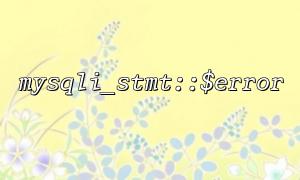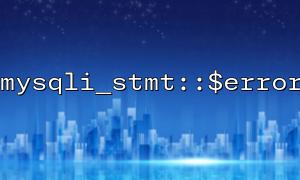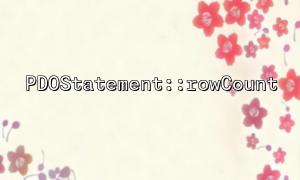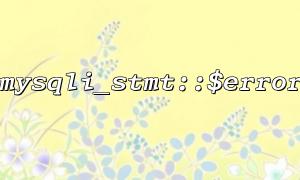Database operations are inevitable when developing PHP applications. If there is no appropriate error handling mechanism, we will often be troubled by the errors hidden behind it. For better troubleshooting and debugging, mysqli_stmt::$error is a very useful tool. This article will introduce how to use mysqli_stmt::$error to locate and troubleshoot errors in database operations, especially for beginners.
mysqli_stmt::$error is a property in the MySQLi extension that is used to obtain the last error message related to a SQL statement preparation process. Usually, if SQL execution fails during database operations, the $error attribute will return an error message, helping developers quickly locate problems.
In PHP, the mysqli_stmt object is used to represent prepared statements. Preprocessing statements can effectively prevent SQL injection and improve the performance of SQL queries. Whenever a database operation is performed, we can ensure that the query is successful by checking mysqli_stmt::$error .
Let's first take a look at a simple example showing how to troubleshoot errors using mysqli_stmt::$error in PHP.
<?php
// Connect to the database
$mysqli = new mysqli("localhost", "username", "password", "database");
// Check database connections
if ($mysqli->connect_error) {
die("Connection failed: " . $mysqli->connect_error);
}
// Prepare SQL Query
$query = "INSERT INTO users (username, email) VALUES (?, ?)";
$stmt = $mysqli->prepare($query);
// examine SQL 语句是否Prepare成功
if ($stmt === false) {
die('Prepare语句失败: ' . $mysqli->error);
}
// Bind parameters
$username = "testuser";
$email = "[email protected]";
$stmt->bind_param("ss", $username, $email);
// Execution statement
if (!$stmt->execute()) {
echo "Execution failed: " . $stmt->error; // use mysqli_stmt::$error To get error information
} else {
echo "Data insertion successfully!";
}
// Close statements and connections
$stmt->close();
$mysqli->close();
?>
Connect to the database : We first connect to the MySQL database through new mysqli() and check whether the connection is successful.
Prepare SQL statements : Prepare SQL statements through the $mysqli->prepare() method. If the preparation fails, the error message will be obtained through $mysqli->error .
Bind parameters : We use the bind_param() method to bind variables to preprocessing statements to ensure security.
Execute statement : Execute the statement through $stmt->execute() . If the execution fails, you can get the specific error information through $stmt->error .
Through mysqli_stmt::$error , we can clearly know the reason for the operation failure. For complex database queries, the rational use of this property can help us effectively locate problems.
During the development process, we often encounter database operation errors. Without proper error handling, it may lead to the inability to quickly find the problem. Using mysqli_stmt::$error can help us:
Quickly locate errors : quickly understand the cause of the error by viewing the error message.
Improve code robustness : By processing error messages, the risk of program crashing when database operations fail is avoided.
Debugging and testing : During the development process, timely capture error information can be accelerated, and development efficiency can be improved.
Here are some common examples of mysqli_stmt::$error error messages:
"Duplicate entry" : When inserting duplicate data, it is usually a primary key or a unique index conflict.
"Unknown column" : A non-existent column is referenced in the query.
"Syntax error" : SQL syntax error.
Understanding these common error messages can help us quickly determine the type of problem when we encounter problems.
Using mysqli_stmt::$error is an effective database error troubleshooting method. By checking error messages returned during SQL execution, beginners can locate and fix problems more quickly. After mastering this tool, we can not only improve development efficiency, but also make our PHP programs more robust and stable.
Related Tags:
mysqli_stmt














